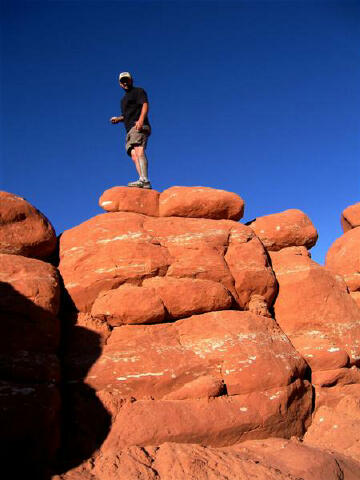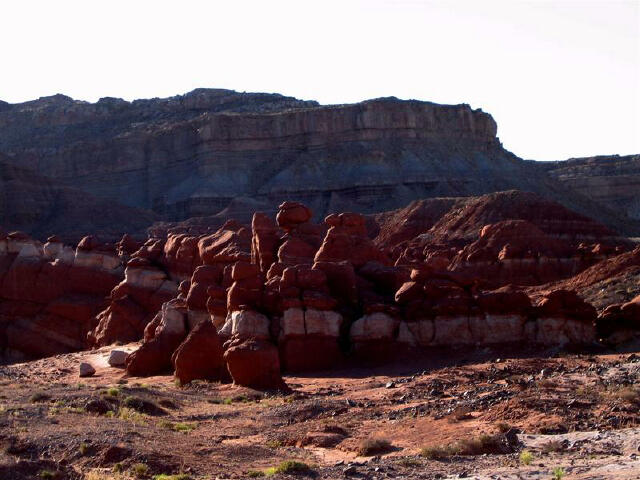[ Homepage
] [ Introduction ] [ Warning ] [ Ratings
] [ Ethics ] [ Feedback ] [ Updates
]
 |
Little Egypt
Henry Mountains
Desert Hiking
Little
Egypt is a playground for children of all ages. The area contains thousands of
twisted and mushroom shaped pinnacles. You will experience an overwhelming desire to
wander through the labyrinth of hoodoos and admire the beauty.
Numerous rocks and coves offer
unrestricted hiking. A vivid imagination will make your visit even more fun. Add
year-round solitude in a remote desert setting and you have a great family destination. |
General Information:
 Little Egypt is a fun place to visit for an hour or
two. Children will enjoy playing on the numerous hoodoos in the area. Photographers can
spend hours waiting for the right light to obtain the perfect picture. The area is little
known and you will most likely have complete solitude while visiting. Little Egypt is
often used as a base for hiking and canyoneering in the region. The area is similar to Goblin Valley State Park but does not require an entrance
fee.
Little Egypt is a fun place to visit for an hour or
two. Children will enjoy playing on the numerous hoodoos in the area. Photographers can
spend hours waiting for the right light to obtain the perfect picture. The area is little
known and you will most likely have complete solitude while visiting. Little Egypt is
often used as a base for hiking and canyoneering in the region. The area is similar to Goblin Valley State Park but does not require an entrance
fee.
This
geologic area showcases strange and sometimes grotesque stone hoodoos that bring to mind
the magnificent temples of ancient Egypt, hence its name Little Egypt Geologic Site.
Trailhead Information:
Any vehicle can access the trailhead during good weather. The
area is criss-crossed with roads. Stay on the road described until told to turn off
of it.
From the
Utah town of Hanksville drive south on highway 95 for 20 miles to mile marker 20.3 (N38°
05' 50", W110° 37' 17"). At this point a well-maintained gravel road crosses
Highway 95. Turn west onto the well-maintained gravel road and follow it for 1.7 miles to
a small spur road heading west (right). Follow this small spur road 100-yards to where it
ends overlooking Little Egypt. This is the Trailhead (N38° 04' 42", W110° 37'
39"). Primitive camping is available in
the area.
How
Hoodoos are Created:
Weathering and erosion carves
hoodoos (i.e., Egyptian temples, goblins, and cathedrals) into the Entrada Sandstone. This
is the same formation that also erodes to arches, fins, and spires in Arches National
Park.
Joint sets (fractures) within the
Entrada’s fine-grained sandstone beds play an important role in hoodoo development by
creating initial zones of weakness. Unweathered joints intersect to form sharp edges and
corners.
These edges and corners are more
susceptible to weathering because they have a greater surface-area-to-volume ratio than
the faces. As a result, they weather more quickly, producing rounded hoodoos through a
process called spheroidal weathering.
Spheroidal weathering helps shape
the hoodoos, but it is only part of the larger erosion process that forms and exhumes the
hoodoos.
Interbedded and underlying shale
and siltstone beds are less resistant to weathering and erosion than the hoodoo’s
sandstone beds. Combined with spheroidal weathering of the sandstone beds, these softer
shale and siltstone beds can give the hoodoos a stacked appearance, elongated shapes, and
flat bottoms.
Additionally, variation in the
amount and type of cementation (between grains in sedimentary rocks) may act as a
secondary control on the unusual shapes of individual hoodoos.
Similar to rocks all across
southeastern Utah, the Entrada’s reddish hue comes from minute quantities of hematite
(iron oxide). The whiter areas result from bleaching by ground water that chemically
removed the hematite (or rendered it colorless) before the rocks were exhumed by erosion.
[ Homepage
] [ Introduction ] [ Warning ] [ Ratings
] [ Ethics ] [ Feedback ] [ Updates
]
© Copyright 2000-,
Shane Burrows |




